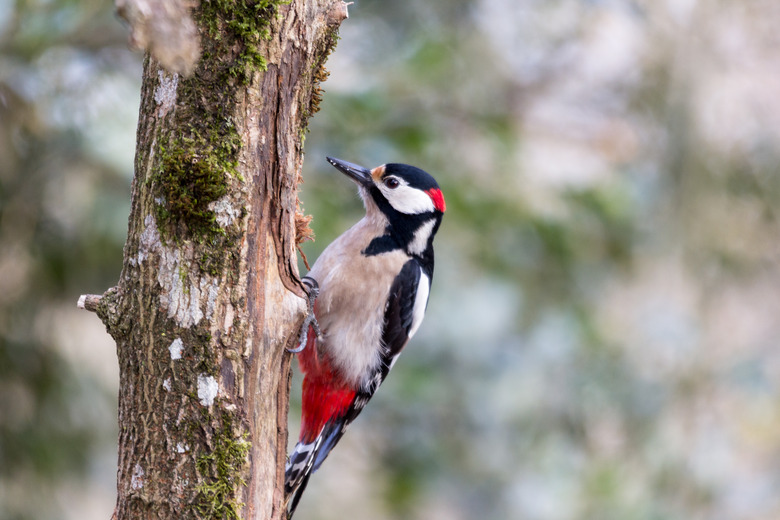The Difference Between Female & Male Pileated Woodpeckers
The Pileated Woodpecker is an impressive bird, due in part to its large size, which is comparable to a crow. It is the second-largest woodpecker in North America, second only to the Ivory Billed Woodpecker, which is nearly extinct. In spite of the Pileated Woodpecker's size, it is an agile and shy bird, making it difficult to stalk. The bird has a bright red crest, long, heavy beak and large white linings under its wings, which are visible when the bird is in flight. The differences between the male and female woodpeckers are subtle. To observe these elusive birds is memorable.
Variations in the Crest
Variations in the Crest
Perhaps the most distinguishing characteristic of this giant woodpecker is the flaming red crest that is common to both the male and the female. At a glance, the crest might look identical, but, upon closer observation, there is a difference between the male's and the female's crests. The red in the male's crest extends all the way down to the beak. On the female Pileated woodpecker , however, the red crest stops short of the beak, where it meets a patch of black. It is a subtle difference and may be difficult to observe casually.
Building the Nest
Building the Nest
Peculiar to the woodpecker family is their ability to excavate trees while nesting. They are able to do this because of their sturdy beaks and the fluid that cushions their brains while they excavate. Woodpeckers' cavities are round or oval, except for the cavities made by the Pileated Woodpecker. Their cavities are either square or rectangular. The male does most of the excavating. Even though the female Pileated Woodpecker assists the male, it is the male who does most of the excavating when building the nest.
Facial Markings
Facial Markings
Unlike many species of birds that have pronounced difference in colors between the sexes, both males and female woodpeckers are black, red and white. Their profiles look very much alike. Upon closer examination, however, you will observe that there is a red "mustache" on the male. The female Pileated Woodpecker lacks this color, and her "mustache" is black. Again, this is a field marking that is difficult to see without the aid of binoculars.
Nesting Behavior
Nesting Behavior
The female Pileated Woodpecker lays a clutch of four to six eggs in a tree cavity. Both the male and the female woodpeckers feed and watch over their young for the first four weeks, until the young leave the nest. The female sleeps in the cavity with the young at night, while the male will sometimes sleep in a cavity that they had previously inhabited. These cavities typically measure about 3 1/2-inches in diameter. Characteristic of these cavities is that they are more square in shape than the round cavities typical of other woodpeckers.
Cite This Article
MLA
Love, Mary. "The Difference Between Female & Male Pileated Woodpeckers" sciencing.com, https://www.sciencing.com/difference-female-male-pileated-woodpeckers-7831988/. 22 November 2019.
APA
Love, Mary. (2019, November 22). The Difference Between Female & Male Pileated Woodpeckers. sciencing.com. Retrieved from https://www.sciencing.com/difference-female-male-pileated-woodpeckers-7831988/
Chicago
Love, Mary. The Difference Between Female & Male Pileated Woodpeckers last modified March 24, 2022. https://www.sciencing.com/difference-female-male-pileated-woodpeckers-7831988/
